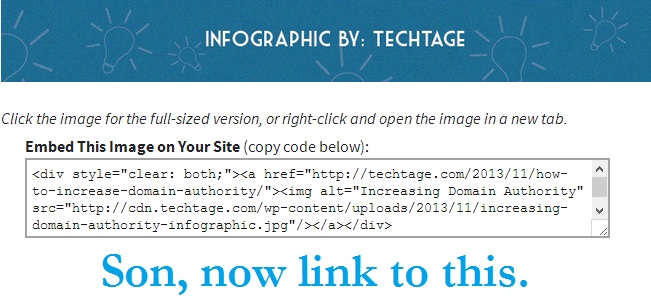
Infographics are quite popular among inbound marketers and websites in technologically sound industries. You can produce infographics as part of your current content marketing campaign and see the light of some additional benefits.
One of the most lucrative benefits of publishing an infographic is the backlinks that it acquires over-time. As infographics tend to seem more intriguing to people than plain text, they tend to be shared more than traditional blog posts or any other textual form of content. The vast number of shares and more importantly, backlinks, offer unparalleled SEO perks to websites.
Since, infographics can be often get costly to produce, in this post I’m gonna talk about how you can make the most of your published infographics and earn more links to them.
Let’s take an overview of some great edges that infographics have over traditional textual content:
- Infographics are more re-publishable than normal blog posts. With the help of embed codes, people can simply copy and paste a block of code to share a great infographic.
- You’ll get a significant amount of referral traffic from all the websites that share your infographic.
- Infographics increase your brand exposure. High-quality infographic designs are a symbol of a trusted brand.
- You’ll get naturally placed backlinks from a considerable amount of websites for your infographic. This will help your site perform better in search engines and bring in more organic visitors to your site.
So, here are a few strategies you can leverage, personally tested by me, for your own infographic marketing campaign:
1. Generate a Clean Embed Code
Infographic marketing campaigns should start with a clean looking and compatible-with-everything embed code. If you’re using WordPress, you can install this plugin which will do the job for you by automatically adding embed codes below your posts containing an infographic. You can, of course, customize the settings and choose when to show it and when to not.
Alternatively, you can use this really handy embed code generator by Siege Media.
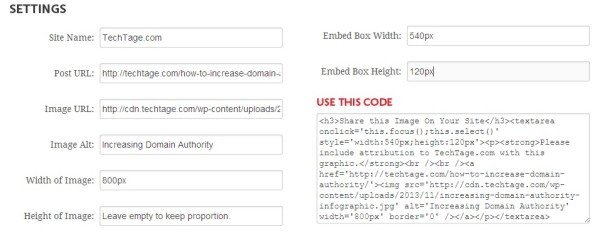
One thing you should make sure is that you don’t use keyword-rich anchor-text in your embed code. Instead use your brand name or the naked site URL or even your personal name. The reason behind this is that Google Penguin, the much dreaded anti-spam algorithm, specifically looks at links posted solely for SEO intents.
So, if I were to choose an anchor-text for my embed code, I’d choose simply ‘TechTage’ or ‘Rohit Palit’ (or “by Rohit Palit”), and NOT ‘best SEO blog’ (example of a keyword-rich anchor-text).
2. Ask Viewers to Post the Infographic on Their Personal Site(s)
This may sound too easy to be effective, but in truth, it is effective. You can’t imagine what a simple but not too generic “share it on your blog” or “share it on your own site” message above or below the embed code can do in terms of increasing the reach of your infographic.
Well, you can ask the viewers to share it only if they find it useful or they simply like it. You can additionally let them know that by sharing it on their own site(s), they’ll actually be helping you, a lot. So, if you’re generally helpful when posting replies to user comments, and helping your readers in general, this could be a nice, easy opportunity for your readers to just return the generosity a bit.
3. Email Popular Sites in Your Niche With a Track Record of Sharing Infographics
The title says it all. Now, how do you exactly find such sites? Here are a few ways to do just that:
- The simplest way would be to use your memory and try to remember considerably good or established sites in your niche that recently re-published an infographic. You can directly approach such sites by shooting them an email.
- If you come across a relatively popular infographic related to one you’ve just published, try to know which all sites linked to it. If it was posted on a trackback-enabled WordPress site, it’s fairly easy to know from the list of trackbacks.
- Even if there’s no list of trackbacks below the post, you can use a service like Ahrefs or Majestic SEO to get the URLs of a fair amount of linking domains.
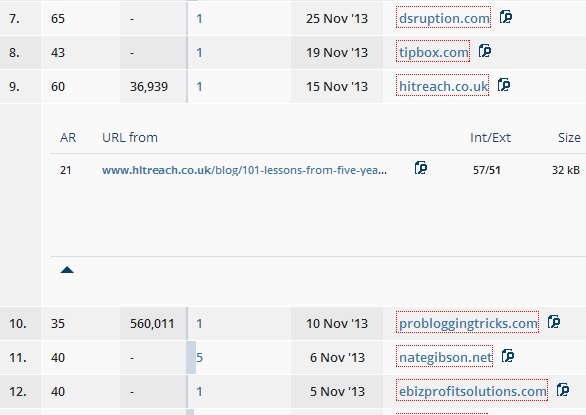
4. Use Google’s Reverse Image Search to Find More Infographic Sharers
Sites that have already shared an infographic similar to yours in the past, are more likely to share yours, as well. Just plain outreach isn’t effective, targeted outreach is. So, if you create a graphic on ‘how to select the default printer in Firefox on Linux’ (thanks to Matt Cutts for the easily memorable micro-niche) and you pitch Huffington Post, sure as hell they are going to ignore your email.
Suppose you published an infographic on smartphones. You can easily get a nice list of sites that have already shared a smartphone infographic before. You first have to find another smartphone infographic. To do that, just google for: “keyword” “infographic”
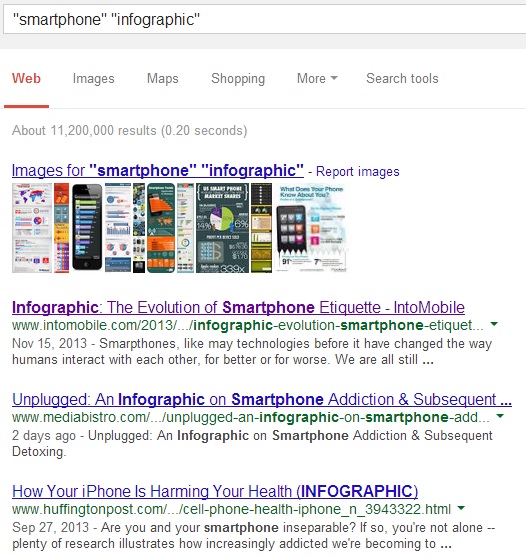
Remember that if an infographic on a fairly competitive topic wasn’t popular or didn’t attract many links, it wouldn’t be ranking on the first page of Google. So, once you’ve opened a page containing a promising infographic, you now have to search in Google for that exact image. There are two ways you can do it. Either, right-click on the image and click on ‘copy image URL’ and then search in Google images for that exact image (paste the URL there). OR, if you’re using Google Chrome, you can directly choose ‘search in Google for this image’ from the right-click menu. It looks like this:
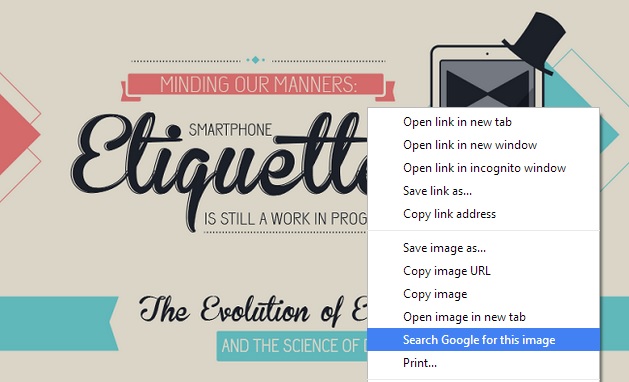
You’ll get a nice list of pages that all contain the infographic. So, you can easily get the names of a few nice sites that share infographics related to your own one.
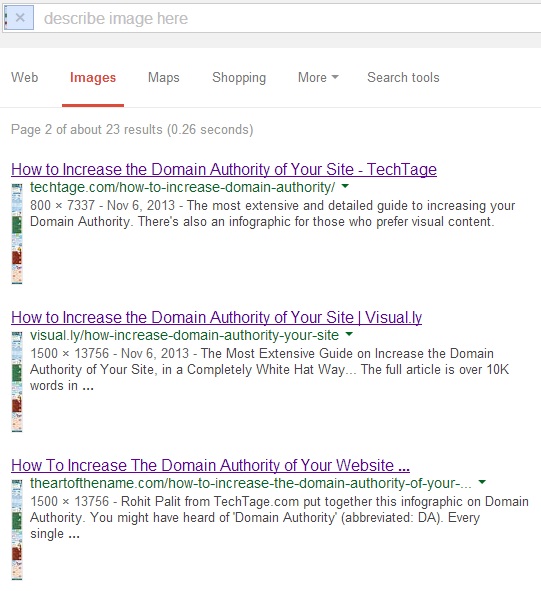
You can then use your judgement to determine which sites are easy to get your infographic posted on. Then you can simply email those sites and try to get your infographic posted on them. I personally wouldn’t recommend revealing your true intention in the first email.
You can just let them know that you’ve published an infographic on [topic] and ask them if they want to see it or not. This doesn’t sound spammy, so in most cases they’d reply you back giving you the permission to show them your infographic.
Once they see it and hopefully email you back saying they like it, you can then try to sound casual and ask them to place the infographic on their sites if they’d like to do so. Say it’s easy to embed, and if possible, paste the embed code in the next email so they have to spend as less energy as possible to post your infographic on their sites. This works really well, usually. 🙂
5. Approach Infographic Directories with a Unique Description for Your Infographic
There are tons of free infographic directories that you can submit your infographic to, in exchange for a backlink or two. This TrafficPlanet thread lists a lot of those directories.
While low or medium quality directories won’t ask for anything else apart from the infographic itself, relatively higher quality infographic directories want a short (around 75-100 words) but unique description for each submitted infographic.

That resulted in:
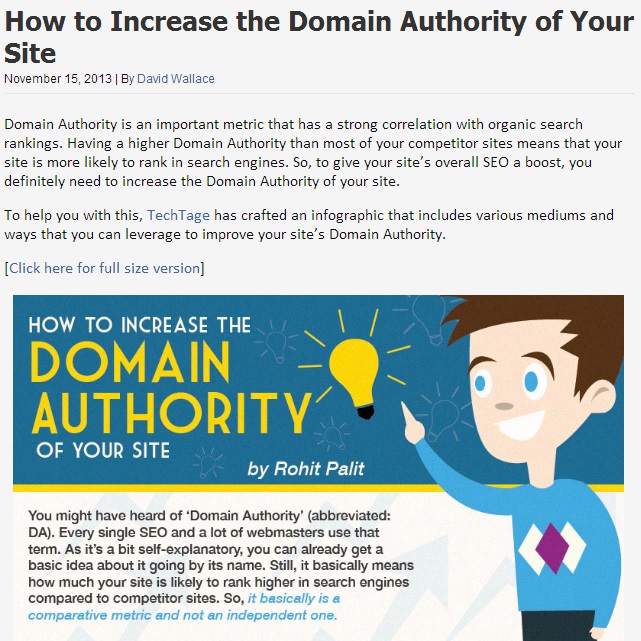
So, if you’re prepared to write ten variants of a short description for your infographic to submit it to ten different decent quality directories, this should be your thing. What’s more, these links often tend to be quite powerful, and helps with the ranking of your original page containing the infographic, while having no chance of inviting a Google penalty.
6. Share Your Infographic on Image Sharing Sites with a Focus on Visual Content
You can share your infographic for free on sites like Visual.ly and Pinterest. If your infographic is good and manages to draw the attention of people in these very popular sites, the increased exposure may ensure more chances of your infographic to attract even more shares and backlinks.

You can also submit it to Flickr, Reddit/r/infographics, Imgur and a few other sites. This’ll also bring in some additional traffic to your site as you can place a link to the original publication below your infographic.
7. Leverage Your Relationships to Gain Links and Shares
If you have good relationships with fellow bloggers and site owners, you can send them personalized emails or alternatively let them know on social media about your infographic. So, this way, you can get links directly if they share it on some site, or you can increase your chances of getting links thanks to the increased exposure of your infographic as a result of their social shares.
This is how Brian Dean managed to get his infographic published on the famous Entrepreneur Magazine.
8. Target Industry Specific Forums and Communities
Industry-specific communities can be a great way to promote a great piece of visual content within the community. Inbound.org is such a community for inbound marketing enthusiasts.
When my Domain Authority infographic got shared on Inbound.org, it helped a lot with the promotion of it:
- It brought around 200 unique visitors within a span of two days to the site.
- The shared links on Inbound.org are dofollow, so that means the more people that upvotes it on Inbound, the more number of profiles will link to it (internal links) and the more link juice my original post on this site will get.
- It received a lot of acclaim from the Inbound community and collected 81 upvotes, which is high by their standards.
Some even left good words for it on Inbound which helped it prove its value to would-be visitors:
Very nice post young grasshopper
This is actually so comprehensive, you can turn it into a book with a couple of more lines. But seriously, this pretty much nails everything one needs to do good SEO in this day and age. I am gonna share the shit outta this one! 😉
The post features very actionable tips and I would recommend that anyone that wishes to get the best out of it download it and convert it to PDF for later read! It’s actually that long! Very good job Rohit and I look forward to more of this 🙂
If you manage to impress the brightest minds in your industry, you surely have a chance to get some high-quality links. No wonder that infographic got links from SearchEngineLand and a lot of other high-authority sites.
9. Utilize Paid Social Media Ads
When you publish a great infographic you have a lot of confidence in, you can help it out with some initial traffic by resorting to paid social media ads. Some of the platforms work really well for blog contents.
I’ve personally tried StumbleUpon’s paid discovery (you can get hundreds of visitors @ $0.10 per visitor), Facebook promoted posts (works moderately well) and Reddit’s promoted entries (sometimes works amazingly well, sometimes not that great).
The good thing about advertising in social media sites is that, if the people who see your promoted ads like, upvote, share it, the more will be the reach of the promoted piece of content organically across the network.
If you’re not too sure about which social media site you should proceed with first for paid promotion, check out this awesome blog post by Neil Patel that compares quite a few advertising platforms.
Conclusion
Infographics can not only attract more eye balls than a normal text-based blog post, it can also draw in more backlinks than a traditional textual content piece as well. However, you can hit the jackpot by publishing an infographic alongside textual content, like a blog post. That’s what I did with my Domain Authority infographic and it just made it more valuable to everyone and garnered links from around 40 unique domains within a week or so.
However, creating an awesome infographic that people will love is only half the battle. What’s the use of that if people don’t even know your infographic exists? That’s the reason why, like in any other type of content marketing campaign, you shouldn’t forget the ‘marketing’ in ‘content marketing’.
Getting your infographic out in front of the right people at the right time can gain you links in an unparalleled fashion. Infographics are a powerful weapon of every sensible content marketer, and that’s one of the reasons why they’re still the hot property among SEOs and link builders.
So, have you published your first infographic yet? What other ways did you take advantage of to promote it to get more backlinks?
